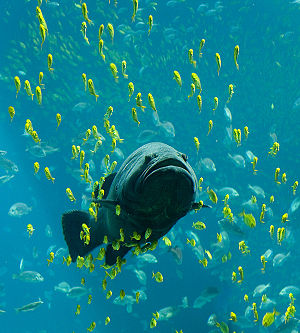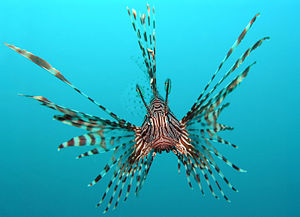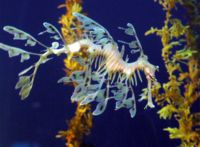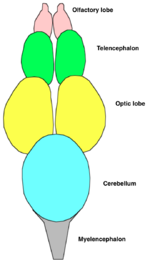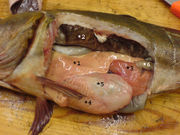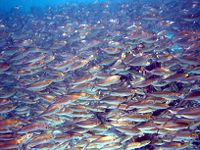Fish
2008/9 Schools Wikipedia Selection. Related subjects: Insects, Reptiles and Fish
Fish are aquatic vertebrates that are typically ectothermic (previously cold-blooded), covered with scales, and equipped with two sets of paired fins and several unpaired fins. Fish are abundant in the sea and in fresh water, with species being known from mountain streams (e.g., char and gudgeon) as well as in the deepest depths of the ocean (e.g., gulpers and anglerfish). They are of tremendous importance as food for people around the world, either collected from the wild (see fishing) or farmed in much the same way as cattle or chickens (see aquaculture). Fish are also exploited for recreation, through angling and fishkeeping, and are commonly exhibited in public aquaria. Fish have an important role in many cultures through the ages, ranging as widely as deities and religious symbols to subjects of books and popular movies.
Definition
The term "fish" is most precisely used to describe any non- tetrapod chordate, (i.e., an animal with a backbone), that has gills throughout life and has limbs, if any, in the shape of fins. Unlike groupings such as birds or mammals, fish are not a single clade but a paraphyletic collection of taxa, including hagfishes, lampreys, sharks and rays, ray-finned fishes, coelacanths, and lungfishes.
A typical fish is ectothermic; has a streamlined body that allows it to swim rapidly; extracts oxygen from the water using gills or an accessory breathing organ to enable it to breath atmospheric oxygen; has two sets of paired fins, usually one or two (rarely three) dorsal fins, an anal fin, and a tail fin; has jaws; has skin that is usually covered with scales; and lays eggs that are fertilized internally or externally.
To each of these there are exceptions. Tuna, Swordfish, and some species of sharks show some warm-blooded adaptations, and are able to raise their body temperature significantly above that of the ambient water surrounding them. Streamlining and swimming performance varies from highly streamlined and rapid swimmers which are able to reach 10-20 body-lengths per second (such as tuna, salmon, and jacks) through to slow but more maneuverable species such as eels and rays that reach no more than 0.5 body-lengths per second. Many groups of freshwater fish extract oxygen from the air as well as from the water using a variety of different structures. Lungfish have paired lungs similar to those of tetrapods, gouramis have a structure called the labyrinth organ that performs a similar function, while many catfish, such as Corydoras extract oxygen via the intestine or stomach. Body shape and the arrangement of the fins is highly variable, covering such seemingly un-fishlike forms as seahorses, pufferfish, anglerfish, and gulpers. Similarly, the surface of the skin may be naked (as in moray eels), or covered with scales of a variety of different types usually defined as placoid (typical of sharks and rays), cosmoid (fossil lungfishes and coelacanths), ganoid (various fossil fishes but also living gars and bichirs, cycloid, and ctenoid (these last two are found on most bony fish. There are even fishes that spend most of their time out of water. Mudskippers feed and interact with one another on mudflats and are only underwater when hiding in their burrows. The catfish Phreatobius cisternarum lives in underground, phreatic habitats, and a relative lives in waterlogged leaf litter.
Fish range in size from the 16 m (51 ft) whale shark to the 8 mm (just over ¼ of an inch) long stout infantfish.
Many types of aquatic animals commonly referred to as "fish" are not fish in the sense given above; examples include shellfish, cuttlefish, starfish, crayfish and jellyfish. In earlier times, even biologists did not make a distinction - sixteenth century natural historians classified also seals, whales, amphibians, crocodiles, even hippopotamuses, as well as a host of aquatic invertebrates, as fish. In some contexts, especially in aquaculture, the true fish are referred to finfish (or fin fish) to distinguish them from these other animals.
Classification
Fish are a paraphyletic group: that is, any clade containing all fish also contains the tetrapods, which are not fish. For this reason, groups such as the "Class Pisces" seen in older reference works are no longer used in formal classifications.
Fish are classified into the following major groups:
- Subclass Pteraspidomorphi (early jawless fish)
- Class Thelodonti
- Class Anaspida
- (unranked) Cephalaspidomorphi (early jawless fish)
- (unranked) Hyperoartia
- Petromyzontidae ( lampreys)
- Class Galeaspida
- Class Pituriaspida
- Class Osteostraci
- (unranked) Hyperoartia
- Infraphylum Gnathostomata (jawed vertebrates)
- Class Placodermi (armoured fishes, extinct)
- Class Chondrichthyes (cartilaginous fish)
- Class Acanthodii (spiny sharks, extinct)
- Superclass Osteichthyes (bony fish)
- Class Actinopterygii (ray-finned fish)
- Class Sarcopterygii (lobe-finned fish)
- Subclass Coelacanthimorpha ( coelacanths)
- Subclass Dipnoi ( lungfish)
Some palaeontologists consider that Conodonta are chordates, and so regard them as primitive fish. For a fuller treatment of classification, see the vertebrate article.
The various fish groups taken together account for more than half of the known vertebrates. There are almost 28,000 known extant species of fish, of which almost 27,000 are bony fish, with the remainder being about 970 sharks, rays, and chimeras and about 108 hagfishes and lampreys. A third of all of these species are contained within the nine largest families; from largest to smallest, these families are Cyprinidae, Gobiidae, Cichlidae, Characidae, Loricariidae, Balitoridae, Serranidae, Labridae, and Scorpaenidae. On the other hand, about 64 families are monotypic, containing only one species. It is predicted that the eventual number of total extant species will be at least 32,500.
Anatomy
Digestive system
The advent of jaws allowed fish to eat a much wider variety of food, including plants and other organisms. In fish, food is ingested through the mouth and then broken down in the esophagus. When it enters the stomach, the food is further broken down and, in many fish, further processed in fingerlike pouches called pyloric caeca. The pyloric caeca secrete digestive enzymes and absorb nutrients from the digested food. Organs such as the liver and pancreas add enzymes and various digestive chemicals as the food moves through the digestive tract. The intestine completes the process of digestion and nutrient absorption.
Respiratory system
Most fish exchange gases by using gills that are located on either side of the pharynx. Gills are made up of threadlike structures called filaments. Each filament contains a network of capillaries that allow a large surface area for the exchange of oxygen and carbon dioxide. Fish exchange gases by pulling oxygen-rich water through their mouths and pumping it over their gill filaments. The blood in the capillaries flows in the opposite direction to the water, causing counter current exchange. They then push the oxygen-poor water out through openings in the sides of the pharynx. Some fishes, like sharks and lampreys, possess multiple gill openings. However, most fishes have a single gill opening on each side of the body. This opening is hidden beneath a protective bony cover called an operculum.
Juvenile bichirs have external gills, a very primitive feature that they hold in common with larval amphibians.
Many fish can breathe air. The mechanisms for doing so are varied. The skin of anguillid eels may be used to absorb oxygen. The buccal cavity of the electric eel may be used to breathe air. Catfishes of the families Loricariidae, Callichthyidae, and Scoloplacidae are able to absorb air through their digestive tracts. Lungfish and bichirs have paired lungs similar to those of tetrapods and must rise to the surface of the water to gulp fresh air in through the mouth and pass spent air out through the gills. Gar and bowfin have a vascularised swim bladder that is used in the same way. Loaches, trahiras, and many catfish breathe by passing air through the gut. Mudskippers breathe by absorbing oxygen across the skin (similar to what frogs do). A number of fishes have evolved so-called accessory breathing organs that are used to extract oxygen from the air. Labyrinth fish (such as gouramis and bettas) have a labyrinth organ above the gills that performs this function. A few other fish have structures more or less resembling labyrinth organs in form and function, most notably snakeheads, pikeheads, and the Clariidae family of catfish.
Being able to breathe air is primarily of use to fish that inhabit shallow, seasonally variable waters where the oxygen concentration in the water may decline at certain times of the year. At such times, fishes dependent solely on the oxygen in the water, such as perch and cichlids, will quickly suffocate, but air-breathing fish can survive for much longer, in some cases in water that is little more than wet mud. At the most extreme, some of these air-breathing fish are able to survive in damp burrows for weeks after the water has otherwise completely dried up, entering a state of aestivation until the water returns.
Fish can be divided into obligate air breathers and facultative air breathers. Obligate air breathers, such as the African lungfish, must breathe air periodically or they will suffocate. Facultative air breathers, such as the catfish Hypostomus plecostomus, will only breathe air if they need to and will otherwise rely solely on their gills for oxygen if conditions are favourable. Most air breathing fish are not obligate air breathers, as there is an energetic cost in rising to the surface and a fitness cost of being exposed to surface predators.
Circulatory system
Fish have a closed circulatory system with a heart that pumps the blood in a single loop throughout the body. The blood goes from the heart to gills, from the gills to the rest of the body, and then back to the heart. In most fish, the heart consists of four parts: the sinus venosus, the atrium, the ventricle, and the bulbus arteriosus. Despite consisting of four parts, the fish heart is still a two-chambered heart. The sinus venosus is a thin-walled sac that collects blood from the fish's veins before allowing it to flow to the atrium, which is a large muscular chamber. The atrium serves as a one-way compartment for blood to flow into the ventricle. The ventricle is a thick-walled, muscular chamber and it does the actual pumping for the heart. It pumps blood to a large tube called the bulbus arteriosus. At the front end, the bulbus arteriosus connects to a large blood vessel called the aorta, through which blood flows to the fish's gills.
Excretory system
As with many aquatic animals, most fish release their nitrogenous wastes as ammonia. Some of the wastes diffuse through the gills into the surrounding water. Others are removed by the kidneys, excretory organs that filter wastes from the blood. Kidneys help fishes control the amount of ammonia in their bodies. Saltwater fish tend to lose water because of osmosis. In saltwater fish, the kidneys concentrate wastes and return as much water as possible back to the body. The reverse happens in freshwater fish, they tend to gain water continuously. The kidneys of freshwater fish are specially adapted to pump out large amounts of dilute urine. Some fish have specially adapted kidneys that change their function, allowing them to move from freshwater to saltwater.
Sensory and nervous system
Central nervous system
Fish typically have quite small brains relative to body size when compared with other vertebrates, typically one-fifteenth the mass of the brain from a similarly sized bird or mammal. However, some fish have relatively large brains, most notably mormyrids and sharks, which have brains of about as massive relative to body weight as birds and marsupials.
The brain is divided into several regions. At the front are the olfactory lobes, a pair of structure the receive and process signals from the nostrils via the two olfactory nerves. The olfactory lobes are very large in fishes that hunt primarily by smell, such as hagfish, sharks, and catfish. Behind the olfactory lobes is the two-lobed telencephalon, the equivalent structure to the cerebrum in higher vertebrates. In fishes the telencephalon is concerned mostly with olfaction. Together these structures form the forebrain.
Connecting the forebrain to the midbrain is the diencephalon (in the adjacent diagram, this structure is below the optic lobes and consequently not visible). The diencephalon performs a number of functions associated with hormones and homeostasis. The pineal body lies just above the diencephalon. This structure performs many different functions including detecting light, maintaining circadian rhythms, and controlling colour changes.
The midbrain or mesencephalon contains the two optic lobes. These are very large in species that hunt by sight, such as rainbow trout and cichlids.
The hindbrain or metencephalon is particularly involved in swimming and balance. The cerebellum is a single-lobed structure that is usually very large, typically the biggest part of the brain. Hagfish and lampreys have relatively small cerebellums, but at the other extreme the cerebellums of mormyrids are massively developed and apparently involved in their electrical sense.
The brain stem or myelencephalon is the most posterior part of the brain. As well as controlling the functions of some of the muscles and body organs, in bony fish at least the brain stem is also concerned with respiration and osmoregulation.
Sense organs
Most fish possess highly developed sense organs. Nearly all daylight fish have well-developed eyes that have colour vision that is at least as good as a human's. Many fish also have specialized cells known as chemoreceptors that are responsible for extraordinary senses of taste and smell. Although they have ears in their heads, many fish may not hear sounds very well. However, most fishes have sensitive receptors that form the lateral line system. The lateral line system allows for many fish to detect gentle currents and vibrations, as well as to sense the motion of other nearby fish and prey. Some fishes such as catfishes and sharks, have organs that detect low levels electric current. Other fish, like the electric eel, can produce their own electricity.
Pain reception in fish
In 2003, Scottish scientists at the University of Edinburgh performing research on rainbow trout concluded that fish exhibit behaviors often associated with pain. Professor James D. Rose of the University of Wyoming critiqued the study, claiming it was flawed. Rose had published his own study a year earlier arguing that fish cannot feel pain as they lack the appropriate neocortex in the brain.
Muscular system
Most fish move by contracting paired sets of muscles on either side of the backbone alternately. These contractions form S-shaped curves that move down the body of the fish. As each curve reaches the back fin, backward force is created. This backward force, in conjunction with the fins, moves the fish forward. The fish's fins are used like an airplane's stabilizers. Fins also increase the surface area of the tail, allowing for an extra boost in speed. The streamlined body of the fish decreases the amount of friction as they move through water. Since body tissue is more dense than water, fish must compensate for the difference or they will sink. Many bony fishes have an internal organ called a swim bladder that adjust their buoyancy through manipulation of gases.
Reproductive system
Organs
Fish reproductive organs include testes and ovaries. In most fish species, gonads are paired organs of similar size, which can be partially or totally fused. There may also be a range of secondary reproductive organs that help in increasing a fish's fitness.
In terms of spermatogonia distribution, the structure of teleosts testes has two types: in the most common, spermatogonia occur all along the seminiferous tubules, while in Atherinomorph fishes they are confined to the distal portion of these structures. Fishes can present cystic or semi-cystic spermatogenesis in relation to the phase of release of germ cells in cysts to the seminiferous tubules lumen.
Fish ovaries may be of three types: gymnovarian, secondary gymnovarian or cystovarian. In the first type, the oocytes are released directly into the coelomic cavity and then enter the ostium, then through the oviduct and are eliminated. Secondary gymnovarian ovaries shed ova into the coelom and then they go directly into the oviduct. In the third type, the oocytes are conveyed to the exterior through the oviduct. Gymnovaries are the primitive condition found in lungfishes, sturgeons, and bowfins. Cystovaries are the condition that characterizes most of the teleosts, where the ovary lumen has continuity with the oviduct. Secondary gymnovaries are found in salmonids and a few other teleosts.
Oogonia development in teleosts fish varies according to the group, and the determination of oogenesis dynamics allows the understanding of maturation and fertilization processes. Changes in the nucleus, ooplasm, and the surrounding layers characterize the oocyte maturation process.
Postovulatory follicles are structures formed after oocyte release; they do not have endocrine function, present a wide irregular lumen, and are rapidly reabosrbed in a process involving the apoptosis of follicular cells. A degenerative process called follicular atresia reabsorbs vitellogenic oocytes not spawned. This process can also occur, but less frequently, in oocytes in other development stages.
Some fish are hermaphrodites, having testes and ovaries either at different phases in their life cycle or, like hamlets, can be simultaneously male and female.
Reproductive method
Over 97% of all known fishes are oviparous, that is, the eggs develop outside the mother's body. Examples of oviparous fishes include salmon, goldfish, cichlids, tuna, and eels. In the majority of these species, fertilisation takes place outside the mother's body, with the male and female fish shedding their gametes into the surrounding water. However, a few oviparous fishes practise internal fertilisation, with the male using some sort of intromittent organ to deliver sperm into the genital opening of the female, most notably the oviparous sharks, such as the horn shark, and oviparous rays, such as skates. In these cases, the male is equipped with a pair of modified pelvic fins known as claspers.
The newly-hatched young of oviparous fish are called larvae. They are usually poorly formed, carry a large yolk sac (from which they gain their nutrition) and are very different in appearance to juvenile and adult specimens of their species. The larval period in oviparous fish is relatively short however (usually only several weeks), and larvae rapidly grow and change appearance and structure (a process termed metamorphosis) to resemble juveniles of their species. During this transition larvae use up their yolk sac and must switch from yolk sac nutrition to feeding on zooplankton prey, a process which is dependent on zooplankton prey densities and causes many mortalities in larvae.
Ovoviviparous fish are ones in which the eggs develop inside the mother's body after internal fertilization but receive little or no nutrition from the mother, depending instead on the yolk. Each embryo develops in its own egg. Familiar examples of ovoviviparous fishes include guppies, angel sharks, and coelacanths.
Some species of fish are viviparous. In such species the mother retains the eggs, as in ovoviviparous fishes, but the embryos receive nutrition from the mother in a variety of different ways. Typically, viviparous fishes have a structure analogous to the placenta seen in mammals connecting the mother's blood supply with the that of the embryo. Examples of viviparous fishes of this type include the surf-perches, splitfins, and lemon shark. The embryos of some viviparous fishes exhibit a behaviour known as oophagy where the developing embryos eat eggs produced by the mother. This has been observed primarily among sharks, such as the shortfin mako and porbeagle, but is known for a few bony fish as well, such as the halfbeak Nomorhamphus ebrardtii. Intrauterine cannibalism is an even more unusual mode of vivipary, where the largest embryos in the uterus will eat their weaker and smaller siblings. This behaviour is also most commonly found among sharks, such as the grey nurse shark, but has also been reported for Nomorhamphus ebrardtii.
Aquarists commonly refer to ovoviviparous and viviparous fishes as livebearers.
Immune system
Types of immune organs vary between different types of fish. In the jawless fish (lampreys and hagfishes), true lymphoid organs are absent. Instead, these fish rely on regions of lymphoid tissue within other organs to produce their immune cells. For example, erythrocytes, macrophages and plasma cells are produced in the anterior kidney (or pronephros) and some areas of the gut (where granulocytes mature) resemble primitive bone marrow in hagfish. Cartilaginous fish (sharks and rays) have a more advanced immune system than the jawless fish. They have three specialized organs that are unique to chondrichthyes; the epigonal organs (lymphoid tissue similar to bone marrow of mammals) that surround the gonads, the Leydig’s organ within the walls of their esophagus, and a spiral valve in their intestine. All these organs house typical immune cells (granulocytes, lymphocytes and plasma cells). They also possess an identifiable thymus and a well-developed spleen (their most important immune organ) where various lymphocytes, plasma cells and macrophages develop and are stored. Chondrostean fish (sturgeons, paddlefish and birchirs) possess a major site for the production of granulocytes within a mass that is associated with the meninges (membranes surrounding the central nervous system) and their heart is frequently covered with tissue that contains lymphocytes, reticular cells and a small number of macrophages. The chondrostean kidney is an important hemopoietic organ; where erythrocytes, granulocytes, lymphocytes and macrophages develop. Like chondrostean fish, the major immune tissues of bony fish (or teleostei) include the kidney (especially the anterior kidney), where many different immune cells are housed. In addition, teleost fish possess a thymus, spleen and scattered immune areas within mucosal tissues (e.g. in the skin, gills, gut and gonads). Much like the mammalian immune system, teleost erythrocytes, neutrophils and granulocytes are believed to reside in the spleen whereas lymphocytes are the major cell type found in the thymus. Recently, a lymphatic system similar to that described in mammals was described in one species of teleost fish, the zebrafish. Although not confirmed as yet, this system presumably will be where naive (unstimulated) T cells will accumulate while waiting to encounter an antigen.
Evolution
The early fossil record on fish is not very clear. It appears it was not a sufficiently successful animal early in its evolution to leave many fossils. However, this would eventually change over time as it became a dominant form of sea life and eventually branched to create land vertebrates.
The proliferation was apparently due to the formation of the hinged jaw because jawless fish left very few descendants. Lampreys may be a rough representative of pre-jawed fish. The first jaws are found in Placodermi fossils. It is unclear if the advantage of a hinged jaw is greater biting force, respiratory-related, or a combination.
Some speculate that fish may have evolved from a creature similar to a coral-like Sea squirt, whose larvae resemble primitive fish in some key ways. The first ancestors of fish may have kept the larval form into adulthood (as some sea squirts do today), although maybe the reverse of this is case. Candidates for early fish include Agnatha such as Haikouichthys, Myllokunmingia, Pikaia, and Conodonts.
Homeothermy
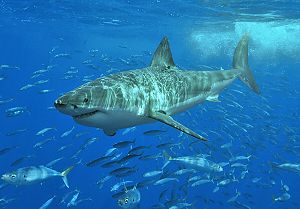
Although most fish are exclusively aquatic and ectothermic, there are exceptions to both cases.
Fish from a number of different groups have evolved the capacity to live out of the water for extended periods of time. Of these amphibious fish, some such as the mudskipper can live and move about on land for up to several days.
Also, certain species of fish maintain elevated body temperatures to varying degrees. Endothermic teleosts (bony fishes) are all in the suborder Scombroidei and include the billfishes, tunas, and one species of "primitive" mackerel (Gasterochisma melampus). All sharks in the family Lamnidae – shortfin mako, long fin mako, white, porbeagle, and salmon shark – are known to have the capacity for endothermy, and evidence suggests the trait exists in family Alopiidae (thresher sharks). The degree of endothermy varies from the billfish, which warm only their eyes and brain, to bluefin tuna and porbeagle sharks who maintain body temperatures elevated in excess of 20 °C above ambient water temperatures. See also gigantothermy. Endothermy, though metabolically costly, is thought to provide advantages such as increased contractile force of muscles, higher rates of central nervous system processing, and higher rates of digestion.
Diseases
Like other animals, fish can suffer from a wide variety of diseases and parasites. To prevent disease they have a variety of non-specific defences and specific defences. Non-specific defences include the skin and scales, as well as the mucus layer secreted by the epidermis that traps microorganisms and inhibits their growth. Should pathogens breach these defences, fish can develop an inflammatory response that increases the flow of blood to the infected region and delivers the white blood cells that will attempt to destroy the pathogens. Specific defences are specialised responses to particular pathogens recognised by the fish's body, in other words, an immune response. In recent years, vaccines have become widely used in aquaculture and also with ornamental fish, for example the vaccines for furunculosis in farmed salmon and koi herpes virus in koi.
Some fish will also take advantage of cleaner fish for removal of external parasites. The best known of these are the Bluestreak cleaner wrasses of the genus Labroides found on coral reefs in the Indian Ocean and Pacific Ocean. These small fish maintain so-called "cleaning stations" where other fish, known as hosts, will congregate and perform specific movements to attract the attention of the cleaner fish. Cleaning behaviours have been observed in a number of other fish groups, including an interesting case between two cichlids of the same genus, Etroplus maculatus, the cleaner fish, and the much larger Etroplus suratensis, the host.
Importance to humans
Economic importance
Recreation
Conservation
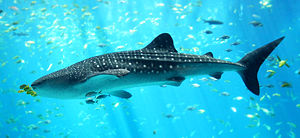
As of 2006, the IUCN Red List describes 1,173 species of fish as being threatened with extinction. Included on this list are species such as Atlantic cod, Devil's Hole pupfish, coelacanths, and great white sharks. Because fish live underwater they are much more difficult to study than terrestrial animals and plants, and information about fish populations is often lacking. However, freshwater fish seem particularly threatened because they often live in relatively small areas. For example, the Devil's Hole pupfish occupies only a single 3 m by 6 m pool.
Overfishing
In the case of edible fishes such as cod and tuna a major threat is overfishing. Where overfishing persists, it eventually causes the collapse of the fish population (known as a "stock") because the population cannot breed fast enough to replace the individuals removed by fishing. One well-studied example of the collapse of a fishery is the Pacific sardine Sadinops sagax caerulues fishery off the coast of California. From a peak in 1937 of 790,000 tonnes the amount of fish landed steadily declined to a mere 24,000 tonnes in 1968, at which point the fishery stopped as no longer economically viable. Such commercial extinction does not mean that the fish itself goes extinct, merely that it can no longer sustain a profitable fishery. The main tension between fisheries science and the fishing industry is the need to balance conservation with preserving the livelihoods of fishermen. In places such as Scotland, Newfoundland, and Alaska the fishing industry is a major employer, so governments have a vested interest in finding a balance between conserving fish stocks while maintaining an economic level of commercial fishing. On the other hand, scientists and conservations push for increasingly stringent protection for fish stocks, warning that many stocks could be wiped out within fifty years.
Habitat destruction
A key stress on both freshwater and marine ecosystems is habitat degradation including water pollution, the building of dams, removal of water for use by humans, and the introduction of exotic species. An example of a fish that has become endangered because of habitat change is the pallid sturgeon, a North American freshwater fish that living in rivers that have all been changed by human activity in a variety of different ways.
Exotic species
Introduction of exotic species has occurred in a variety of places and for many different reasons. One of the best studied (and most severe) examples was the introduction of Nile perch into Lake Victoria. Since the 1960s the Nile perch gradually exterminated the 500 species of cichlid fishes found only in this lake and nowhere else. Some species survive now only in captive breeding programmes, but others are probably extinct. Carp, snakeheads, tilapia, European perch, brown trout, rainbow trout, and sea lampreys are other examples of fish that have caused problems by being introduced into alien environments.
Aquarium collecting
Culture

In the Book of Jonah a "great fish" swallowed Jonah the Prophet. Legends of half-human, half-fish mermaids have featured in stories like those of Hans Christian Andersen and movies like Splash.
Among the deities said to take the form of a fish are Ika-Roa of the Polynesians, Dagon of various ancient Semitic peoples, and Matsya of the Dravidas of India. The astrological symbol Pisces is based on a constellation of the same name, but there is also a second fish constellation in the night sky, Piscis Austrinus.
Fish have been used figuratively in many different ways, for example the ichthys used by early Christians to identify themselves, through to the fish as a symbol of fertility among Bengalis. Fish have also featured prominently in art and literature, as in movies such as Finding Nemo and books such as The Old Man and the Sea. Large fish, particularly sharks, have frequently been the subject of horror movies and thrillers, most notably the novel Jaws, which spawned a series of films of the same name that in turn inspired similar films or parodies such as Shark Tale, Snakehead Terror, and Piranha.
The golden fish (Sanskrit: Matsya), represents in the semiotic of Ashtamangala,(buddhist symbolism) the state of fearless suspension in samsara, thus perceived as the harmless ocean, referred to as 'buddha-eyes' or ' rigpa-sight] '. The fishes symbolises the auspiciousness of all living beings in a state of fearlessness without danger of drowning in the Samsaric Ocean of Suffering, and migrating from teaching to teaching freely and spontaneously just as fish swim.
In the following quotation, the two golden fishes are linked with the Ganges and Yamuna, and nadi, prana and carp:
The two fishes originally represented the two main sacred rivers of India - the Ganges and Yamuna. These rivers are associated with the lunar and solar channels which originate in the nostrils and carry the alternating rhythms of breath & prana. They have religious significance in Hindu, Jain and Buddhist traditions but also in Christianity who is first signified by the sign of the fish, and especially referring to feeding the multitude in the desert. In the dhamma of Buddha the fish symbolize happiness as they have complete freedom of movement in the water. They represent fertility and abundance. Often drawn in the form of carp which are regarded in the Orient as sacred on account of their elegant beauty, size and life-span.
Terminology
Fish or fishes
Though often used interchangeably, these words actually mean different things. Fish is used either as singular noun or to describe a group of specimens from a single species. Fishes describes a group containing more than one species. Hence, as plurals, these words could be used thus:
- My aquarium contains three different fishes: guppies, platies, and swordtails.
- The North Atlantic stock of Gadus morhua is estimated to contain several million fish.
Shoal or school
A random assemblage of fishes merely using some localised resource such as food or nesting sites is known simply as an aggregation. When fish come together in an interactive, social grouping, then they may be forming either a shoal or a school depending on the degree of organisation. A shoal is a loosely organised group where each fish swims and forages independently but is attracted to other members of the group and adjusts its behaviour, such as swimming speed, so that it remains close to the other members of the group. Schools of fish are much more tightly organised, synchronising their swimming so that all fish move at the same speed and in the same direction. Shoaling and schooling behaviour is believed to provide a variety of advantages.
Examples:
- Cichlids congregating at lekking sites form an aggregation.
- Many minnows and characins form shoals.
- Anchovies, herrings, and silversides are classic examples of schooling fishes.
While school and shoal have different meanings within biology, they are often treated as synonyms by non-specialists, with speakers of British English using "shoal" to describe any grouping of fish, while speakers of American English often using "school" just as loosely.
